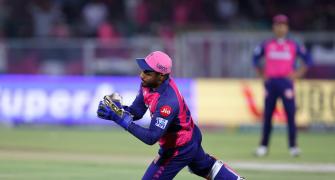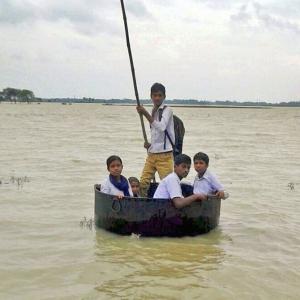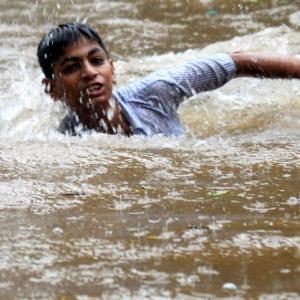'The first two months of the monsoon are not looking good.'
'In case both the halves fail, it is going to be misery.'

The forecast by Skymet, the weather forecasting and agri-risk monitoring company, of the 2019 south west monsoon is not what rain-starved India wants to hear. It predicts below normal rains to the tune of 93% of long period average.
On the other hand, the Indian meteorological department predicts a 'near normal' south west monsoon, which is expected to reach Kerala on June 6, a few days later than the usual June 1.
"Bihar, Jharkhand, West Bengal, MP, Maharashtra, north interior Karnataka, south Madhya Pradesh will experience the effects of a deficit monsoon," G P Sharma, president, Skymet, below, tells Rediff.com's Shobha Warrier.
Skymet predicts a below normal monsoon of 93% of LPA (Long Period of Average). We have had 97% in 2016, 95% in 2017 and 91% in 2018, which means four years of deficient monsoon. What kind of impact will it have on the Indian economy and agriculture?
Agriculture surely will get affected. All these deficits over the years, from one season to the next and then to the next, get accumulated and soil gets stressed, particularly the areas that are largely rain-fed and rain-dependent.
They suffer the most like the central parts of the country which include Madhya Pradesh, Maharashtra and even parts of Rajasthan. These parts are very heavily dependent on monsoon rains.
We haven't seen a good monsoon for a long time, for almost seven years. The best was in 2016 when we could barely reach the normal level.
The irony is that 2019 also follows the same track and possibly we end up another deficient year because of the shadow of El Nino.
So, we will again have below normal monsoon rains.
But IMD predicts a 'near normal' monsoon of 96%...
'Near normal' is a new term that has been coined. We have never used this term to describe the monsoon before.
It was normal, below normal and above normal, and the term near normal was never there. This is for the first time that they are using this term.
Anyway, their next forecast is due in late May or early June. I think they might go in for a revision looking at the conditions. I am not sure. Whether they go in for a revision or not, we say that it looks like June may suffer a lot.
Do you expect any change based on the El Nino effect, like the Pacific Ocean becoming cooler?
The Pacific Ocean will certainly become cooler and that is why we are predicting a good monsoon in the second half of the south west monsoon.
The second half will be better than the first half, keeping in mind the Pacific will possibly cool down.
So, there will be a little relief bettering the rains in the months of August and September. But I still keep my fingers crossed.
I am very confident about the first two months though we have given the forecast for four months. Yes, the first two months of monsoon are not looking good.
In case, both halves fail, it is going to be misery.
Right now, we feel August may possibly help in terms of better rains. Yes, we will get a better projection by the end of June or early July.
Will the Indian Ocean Dipole (also known as the Indian Niño, an irregular oscillation of sea-surface temperatures in which the western Indian Ocean becomes alternately warmer and then colder than the eastern part of the ocean) absorb some of the El Nino effects?
Yes, to some extent.
There are three oceanic factors that come to play during the monsoon season. The strongest one is El Nino followed by IOD and the last and the least is the Madden Julian Oscillation.
The projections are IOD is going to stay neutral in the first half of the monsoon. So, it may not be able to nullify the effects of El Nino. That's why we are projecting poor rains in the first half of the monsoon.
So, a neutral IOD will not help us out in the first half.
But in the second half of the monsoon, IOD becomes positive and may help us out. But again, IOD does not take the complete effects of El Nino; only to some extent.

What were the indictors that made you project a below normal monsoon?
There are a number of models that are available. There are statistical models and there are dynamical models. We take stock of all these models and on top of that, we have our own model that we rely upon, that is the CFS.
We have been testing that for a long time with the last 30 years of data and we found that this model has a correlation with the monsoon of almost 0.8. It means 8 out of 10 times, it is behaving.
Then we have these statistical, dynamical models; so, it is a combination of both the models.
It is not just about El Nino. Sometimes, El Nino has given normal to little above normal rains also.
My reading is any time when El Nino is around, we take it as if it is going to spoil the monsoon rather than believing, sometimes, it will not spoil.
I know sometimes it doesn't spoil, but then this time is not that sometime when it does not spoil!
Last year, the North East monsoon had a deficit of 44%. Is it because of climate change that monsoons are failing for so many years?
Climate change is a reality and it is happening. There is no doubt about that. We cannot close our eyes to it.
El Nino is not because of climate change. Since El Nino causes a lot of warming in the Pacific Ocean, it adds on to the global warming. But not vice versa.
Global warming does not give rise to El Nino, but El Nino adds to global warming.
Is the South West monsoon going to be evenly distributed or will some parts get more, some will be deficient?
The monsoon has never got evenly distributed all over the country at any time.
Even when there is a good monsoon, at least 15% of the country live with a drought-like condition.
And even when we had the worst monsoon, 20% of the country got a good monsoon. So, we cannot expect absolute -- evenly distributed -- monsoon all over the country.
Yes, the pockets are not the same every year. This time, I would say, the indications are that the central and the eastern parts will have deficit rains.
The eastern parts are largely Bihar, Jharkhand and West Bengal and the central parts are MP, Maharashtra, adjacent parts of north interior Karnataka, adjacent parts of the south of Madhya Pradesh extending to some parts of Gujarat. These are the parts that are going to experience the effects of a deficit monsoon.
What about the southern India and the north east?
Southern India will do better and in that, I would say, Kerala, Tamil Nadu and even south interior Karnataka -- which includes Bangalore, Mysore, Mandya, and also coastal Karnataka up to Goa -- will do better.
Rayalseema -- which is Kurnool, Anantpur, Tirupati -- will have less rainfall. Andhra should get okay rain, and coastal AP should do better.
In the case of the north east, it rains very heavily. The large contribution of the monsoon comes from north east India. Even if there is a shortage of 5 to 10% there, they absorb it easily as the rains are very heavy.
This time, north east India is going to have less than normal rainfall. This time also, they will not feel the pinch of a deficit rainfall because of heavy rainfall.
But it is not going to be bountiful to start with in June in Kerala. We will see deficit pan-India rains in June. It will pick up later and overall, it will be normal in Kerala.
So, it is going to be a grim scenario as far as the South West monsoon is concerned...
Yes. Let us hope the second half will be a little better than the first half.
How long can we go on without a proper monsoon?
We have to learn to use our water resources better by filling and using the reservoirs, soil water, and irrigation resources very judiciously and logically.
Look at a small country like Israel in the desert area; there is absolute utilisation of water. We need to do something on those lines.









